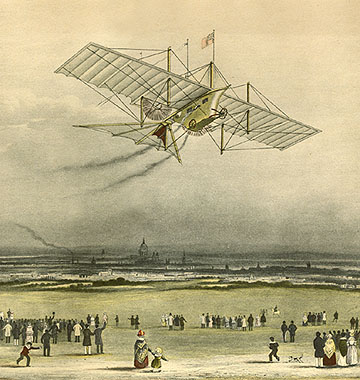 |
|
By
Wikipedia,
the free encyclopedia,
https://en.wikipedia.org/wiki/Steam_aircraft
Steam aircraft are aircraft that are propelled by steam engines. They were unusual devices because of the difficulty in producing a powerplant with a high enough power to weight ratio to be practical. They are distinct from airships that use steam as their lifting gas which are known as thermal airships.

The 1842 Aerial Steam Carriage of Henson and Stringfellow
History
- 1842: The Aerial Steam Carriage of William Samuel Henson and John Stringfellow was patented, but was never successful, although a steam-powered model was flown in 1848.
- 1852: Henri Giffard flies a 3 horsepower (2 kW) steam-powered dirigible over Paris; it was the first powered aircraft.
- 1874: Félix du Temple flies a steam powered aluminium Monoplane off a downhill run. While it did not achieve level flight, it was the first manned heavier-than-air powered flight.
- 1894: Sir Hiram Stevens Maxim (inventor of the Maxim Gun) built and tested a large steam powered aircraft. The machine generated sufficient lift and thrust to break free of the test track and fly but was never operated as a piloted aircraft.
- 1899: Gustave Whitehead built and flew a steam powered airplane in Pittsburgh, Pennsylvania. Stoker/passenger Louis Darvarich was injured when the plane crashed into an upper story of an apartment building. He later flew steam aircraft in Hartford, Connecticut, and was visited by one of the Wright brothers well before 1903.
- 1902: Louis Gagnon flew a steam helicopter in Rossland, British Columbia, called the "Flying Steam Shovel". Control problems caused a crash.
- 1930s: George D. Besler and William J. Besler's prototype steam biplane, based on a Travel Air 2000, flew several times at Oakland airport. It was powered by a two-cylinder, 150 hp (110 kW) reciprocating engine designed by the Doble Steam Motors Company and Besler weighing about 500 lbs and was capable of STOL operation due to the ease of reversing the thrust.
- 1944: A steam-powered version of the Messerschmitt Me 264a was hypothesized but never constructed. This was meant to be powered by a steam turbine developing over 6,000 horsepower (4,500 kW) while driving a 5.3 meter (17' 6") diameter propeller. The fuel would have been a mixture of powdered coal and petroleum. The main considered advantages to this powerplant were consistent power at all altitudes and low maintenance.
- 1960s: Conceptual drawings were made for Don Johnson of Thermodynamic Systems Inc. Newport Beach, CA of an engine. It was to be in installed in a Hughes 300 helicopter. The steam engine was a compact cylindrical double-acting uniflow [similar in layout to the Dyna-Cam Aero engine], but never prototyped by Controlled Steam Dynamics, Inc.
External links
Text from Wikipedia is available under the Creative Commons Attribution/Share-Alike License; additional terms may apply.
Published in July 2009.
Click here to read more articles related to aviation and space!
|
 |



